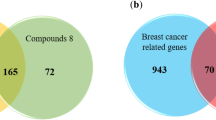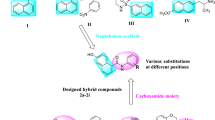Abstract
Upregulation of Heme Oxygenase-1 (HO-1) has been widely implicated in cancer growth and chemoresistance. This explains the numerous drug discovery efforts aimed at mitigating its pro-carcinogenic roles till date. In a recent study, two selective azole-based HO-1 inhibitors (Cpd1 and Cpd2) were synthesized, which exhibited differential inhibitory potencies of ~200μm. Interestingly, variations in the affinities of these compounds were determined by their positioning across specific regions of the HO-1 binding domain, pin-pointing a pharmacological interrelationship that remains unresolved. Therefore, in this study, using molecular dynamics simulations and binding free energy calculations, we investigate how dynamical orientations of these compounds influence their binding affinities at the active HO-1 domain. Findings revealed favorable binding for the bromobenzene and imidazole substituents of Cpd1 at the western and eastern regions of the HO-1 active domain. The constituent hydroxyl group was coordinated by residues Asp140 and Arg136 over the simulation period. On the contrary, stable binding of the bromobenzene and imidazole substituents were negated by the optimal orientations of the benzyl substituent, which extended into the northeastern region. These were supported by the displacement of Asp140 and Arg136, crucial for hydrogen bond formation in Cpd1. Also, we observed that Cpd2 exhibited high deviations indicative of an unstable binding relative to Cpd1. This further supports the presumption that Cpd2 was systematically oriented away from the active HO-1 region, a phenomenon that was due to the optimal motions of the benzyl group at the northeastern regions. The highlight of our findings is that the benzyl substituent in Cpd2 elicited negative effects on HO-1, vis a vis, instability, displacement of crucial residues, and low binding energy when compared to Cpd1. Findings pave the way for future drug discovery efforts related to HO-1 inhibition in cancer therapy.







Similar content being viewed by others
References
Gandini NA et al (2019) Heme oxygenase-1 has an antitumor role in breast cancer. Antioxid Redox Signal 30(18):2030–2049. https://doi.org/10.1089/ars.2018.7554
Greish KF et al (2018) Novel structural insight into inhibitors of heme oxygenase-1 (ho-1) by new imidazole-based compounds: biochemical and in vitro anticancer activity evaluation. Molecules 23(5):1–17. https://doi.org/10.3390/molecules23051209
Salerno L et al (2019) Progress in the development of selective heme oxygenase-1 inhibitors and their potential therapeutic application. Eur J Med Chem 167:439–453. https://doi.org/10.1016/j.ejmech.2019.02.027
Rahman MN et al (2012) A novel, ‘double-clamp’ binding mode for human heme oxygenase-1 inhibition. PLoS ONE 7(1):1–11. https://doi.org/10.1371/journal.pone.0029514
Stocker R, Yamamoto Y, McDonagh AF, Glazer AN, Ames BN (1987) Bilirubin is an anti-oxidant of possible physiological importance. Science (-80) 235(4792):1043–1046. https://doi.org/10.1126/science.3029864
Loboda A, Jozkowicz A, Dulak J (2015) HO-1 induction in cancer progression: a matter of cell adaptation, vol 74. Elsevier, Amsterdam
Loboda A, Damulewicz M, Pyza E, Jozkowicz A, Dulak J (2016) Role of Nrf2/HO-1 system in development, oxidative stress response and diseases: an evolutionarily conserved mechanism. Cell Mol Life Sci 73(17):3221–3247. https://doi.org/10.1007/s00018-016-2223-0
Barañano DE, Rao M, Ferris CD, Snyder SH (2002) Biliverdin reductase: a major physiologic cytoprotectant. Proc Natl Acad Sci USA 99(25):16093–16098. https://doi.org/10.1073/pnas.252626999
He M et al (2015) Heme oxygenase-1-derived bilirubin protects endothelial cells against high glucose-induced damage. Free Radic Biol Med 89:91–98. https://doi.org/10.1016/j.freeradbiomed.2015.07.151
Grochot-Przeczek A, Dulak J, Jozkowicz A (2012) Haem oxygenase-1: Non-canonical roles in physiology and pathology. Clin Sci 122(3):93–103. https://doi.org/10.1042/CS20110147
Nitti M, Piras S, Marinari UM, Moretta L, Pronzato MA, Furfaro AL (2017) HO-1 induction in cancer progression: a matter of cell adaptation. Anti-oxidants 6(2):1–20. https://doi.org/10.3390/antiox6020029
Lin Q et al (2007) Heme oxygenase-1 protein localizes to the nucleus and activates transcription factors important in oxidative stress. J Biol Chem 282(28):20621–20633. https://doi.org/10.1074/jbc.M607954200
Biswas C et al (2014) Nuclear heme oxygenase-1 (HO-1) modulates subcellular distribution and activation of Nrf2, impacting metabolic and anti-oxidant defenses. J Biol Chem 289(39):26882–26894. https://doi.org/10.1074/jbc.M114.567685
Was H, Dulak J, Jozkowicz A (2012) Heme oxygenase-1 in tumor biology and therapy. Curr Drug Targets 11(12):1551–1570. https://doi.org/10.2174/1389450111009011551
Fang J et al (2012) HSP32 (HO-1) inhibitor, copoly(styrene-maleic acid)-zinc protoporphyrin IX, a water-soluble micelle as anticancer agent: In vitro and in vivo anticancer effect. Eur J Pharm Biopharm 81(3):540–547. https://doi.org/10.1016/j.ejpb.2012.04.016
Rahman MN, Vlahakis JZ, Vukomanovic D, Szarek WA, Nakatsu K, Jia Z (2009) X-ray crystal structure of human heme oxygenase-1 with (2R,4S)-2-[2-(4- chlorophenyl)ethyl]-2-[(1H-imidazol-1-yl)methyl]-4[((5-trifluoromethylpyridin-2- yl)thio)methyl]-1,3-dioxolane: a novel, inducible binding mode. J Med Chem 52(15):4946–4950. https://doi.org/10.1021/jm900434f
Pettersen EF et al (2004) UCSF Chimera—A visualization system for exploratory research and analysis. J Comput Chem 25(13):1605–1612. https://doi.org/10.1002/jcc.20084
Webb B, Sali A (2016) Comparative protein structure modeling using MODELLER. Curr Protoc Bioinforma. https://doi.org/10.1002/cpbi.3
Kumi RO, Soremekun OS, Issahaku AR, Agoni C, Olotu FA, Soliman MES (2020) Exploring the ring potential of 2,4-diaminopyrimidine derivatives towards the identification of novel caspase-1 inhibitors in Alzheimer’s disease therapy. J Mol Model 26(4):1–17. https://doi.org/10.1007/s00894-020-4319-6
Hanwell MD, Curtis DE, Lonie DC, Vandermeerschd T, Zurek E, Hutchison GR (2012) Avogadro: an advanced semantic chemical editor, visualization, and analysis platform. J Cheminform. https://doi.org/10.1186/1758-2946-4-17
Allouche A (2012) Software news and updates gabedit—a graphical user interface for computational chemistry softwares. J Comput Chem 32:174–182. https://doi.org/10.1002/jcc
Case DA et al (2018) Amber 18. University of California, San Francisco
Maier JA, Martinez C, Kasavajhala K, Wickstrom L, Hauser KE, Simmerling C (2015) ff14SB: improving the accuracy of protein side chain and backbone parameters from ff99SB. J Chem Theory Comput 11(8):3696–3713. https://doi.org/10.1021/acs.jctc.5b00255
Li P, Merz KM (2016) MCPB.py: a python based metal center parameter builder. J Chem Inf Model 56(4):599–604. https://doi.org/10.1021/acs.jcim.5b00674
Case DA et al (2005) The Amber biomolecular simulation programs. J Comput Chem 26(16):1668–1688. https://doi.org/10.1002/jcc.20290
Jorgensen WL, Chandrasekhar J, Madura JD, Impey RW, Klein ML (1983) Comparison of simple potential functions for simulating liquid water. J Chem Phys 79(2):926–935. https://doi.org/10.1063/1.445869
Ryckaert JP, Ciccotti G, Berendsen HJC (1977) Numerical integration of the cartesian equations of motion of a system with constraints: molecular dynamics of n-alkanes. J Comput Phys 23(3):327–341. https://doi.org/10.1016/0021-9991(77)90098-5
Roe DR, Cheatham TE (2013) PTRAJ and CPPTRAJ: software for processing and analysis of molecular dynamics trajectory data. J Chem Theory Comput 9(7):3084–3095. https://doi.org/10.1021/ct400341p
Seifert E (2014) OriginPro 9.1: Scientific data analysis and graphing software—Software review. J Chem Inf Model 54(5):1552. https://doi.org/10.1021/ci500161d
Kollman PA et al (2000) Calculating structures and free energies of complex molecules: Combining molecular mechanics and continuum models. Acc. Chem. Res. 33(12):889–897. https://doi.org/10.1021/ar000033j
Bös F, Pleiss J (2009) Multiple molecular dynamics simulations of TEM β-lactamase: Dynamics and water binding of the Ω-loop. Biophys J 97(9):2550–2558
Acknowledgments
The authors appreciate the financial and infrastructural support of College of Health Sciences, UKZN and also acknowledge the Centre for High Performance Computing (CHPC, www.chpc.ac.za), Cape Town for provision of computational resource.
Funding
Not applicable.
Author information
Authors and Affiliations
Contributions
FOO conceptualized the study and performed the experiment, OSP, FAO, MES proof-read, and approved for submission.
Corresponding author
Ethics declarations
Conflict of interest:
The authors declare no conflicts of interest in this work.
Additional information
Publisher's Note
Springer Nature remains neutral with regard to jurisdictional claims in published maps and institutional affiliations.
Rights and permissions
About this article
Cite this article
Okunlola, F.O., Soremekun, O.S., Olotu, F.A. et al. East to West not North-West: Structure-Based Mechanistic Resolution of 8-Hydroxyl Replacement and Resulting Effects on the Activities of Imidazole-Based Heme Oxygenase-1 Inhibitors. Protein J 40, 166–174 (2021). https://doi.org/10.1007/s10930-021-09969-6
Accepted:
Published:
Issue Date:
DOI: https://doi.org/10.1007/s10930-021-09969-6




